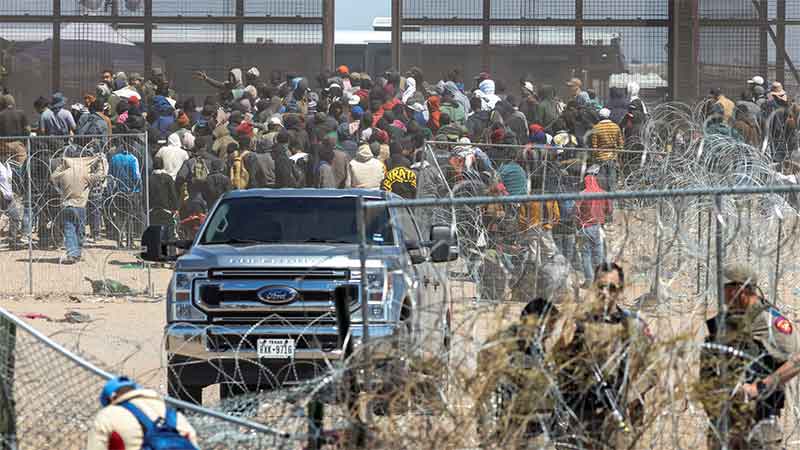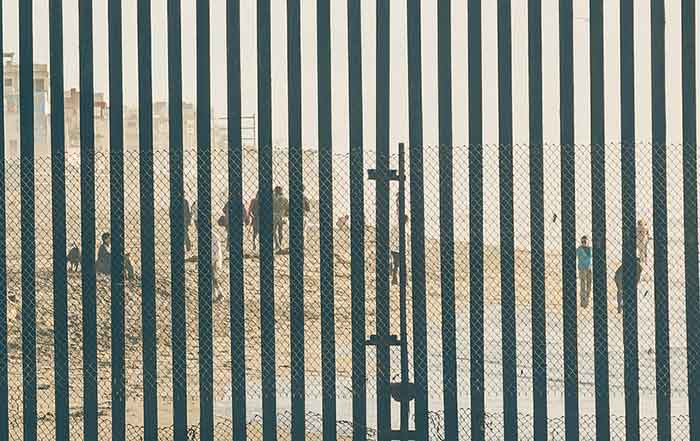
If one had to zero in on biggest the issue that propelled MAGA populism to the forefront of American politics, it is likely to be immigration. The first cause that Trump grabbed at the start of his first campaign back in 2015, and one of many he barely remembered as president, was the abolishment of birthright citizenship. Being born in a particular place inherently means a person is not an immigrant and birthright citizenship is enshrined in the 14th Amendment, which was ratified in 1888. In 2018, Trump did declare “We’re the only country in the world where a person comes in and has a baby, and the baby is essentially a citizen of the United States.” Actually over 30 countries have the same law. But this, along with the mythical border wall that the Mexican government was going to spring for, is of course meant to target undocumented migrants.
In a way it is silly that Trump became so recognized with the anti-migrant cause. After all, there has been pretty strong bipartisan consensus on that for quite a while. The Secure Fence Act of 2006 was signed in law by George W. Bush after passing both houses of Congress with strong majorities including with votes by the likes of Barack Obama, Hillary Clinton, and Chuck Schumer. That act authorized 700 miles worth of fencing along the U.S./Mexico border. This fencing only added to the original border barrier, the Tortilla Wall, which was built between Tijuana and San Diego in the early-1990s, a time when NAFTA was flooding Mexico’s economy with subsidized corn imports displacing many Mexican corn farmers. While California may now be considered the ultimate ‘Blue’ state, in his 1998 classic The Ecology of Fear: Los Angeles and the Imagination of Disaster, Mike Davis explained Los Angeles had at that point become ‘the nation’s capital of racial and sexual orientation violence.’ The Venice-based film American History X featuring Edward Norton’s brilliant portrayal of a reformed neo-Nazi was released that same year.
Listen to the dribble that fills the airwaves and it won’t be long before some blowhard spouts how their family did it ‘the right way’ i.e. migrated legally. Except this does not hold at all for the vast numbers of Americans who claim ancestry from Europe. While immigration from China was barred in the 1882 Chinese Exclusion Act, not repelled until 1943, the first restrictions on immigration from Europe didn’t come into effect until the 1924 Johnson-Redd Act. The targets of the Johnson-Redd Act, which limited immigration visas to two percent of the total number of people of each nationality according to the census of 1890, were Southern and Eastern Europeans (Jews, Italians, Greeks). Ironically, by then the act favored immigration from Ireland and Germany, the groups that provoked the first immigration panic a couple of generations earlier. Meanwhile, Asian Americans are now often declared the ‘model minority.’
The last major bipartisan immigration reform was the Immigration Reform and Control Act of 1986 signed into law by Ronald Reagan, which did provide amnesty to 2.7 undocumented immigrants (the last real amnesty) but also fired the opening shot for militarized border security. Since the early 1990s the amount of funding that goes into border patrol has skyrocketed from $263 million in 1990 to $4.9 billion this year. Since the creation of the Department of Homeland Security in 2003, U.S. Immigrant and Customs Enforcement (ICE) has about tripled, from $3.3 billion to over $8 billion today. Judging by the headlines none of this has put much of a dent on migration. It has only strained the amnesty system or made migrating more dangerous as migrants have been forced to take hazardous routes. Exact numbers are hard to find but likely around 9000 migrants deaths have been recorded at the U.S.-Mexico border since 1998, making it the world’s deadliest land route for migrants (the most dangerous route overall is the Mediterranean Sea where around 28,000 people have perished over the last decade trying to cross).
Back during that original immigration panic, hundreds of thousands of refugees from Ireland’s Great Famine fled to New York City (then only Manhattan Island). In 1845, when the famine began, New York had a population of 350,000. Over the ensuing decade, the city’s population nearly doubled. Despite the presence of nativists groups like the Know-Nothings (strangely called the Native-American Party), the city managed fine.
Compare that to the situation in New York today. In 1855 one out of every four New Yorkers was an Irish Famine refugee. Today’s ‘migrants’ barely make up 2 percent of the population. Since 2022, 180,000 asylum-seekers have passed through New York’s intake system, most infamously those bused there from Southern border-states (the largest percentage coming from Venezuela). This has been enough to send the city into budget panic and provoke New York’s mayor Eric Adams to start suing bus companies. As migrants have been shipped to blue states that only a few years ago featured places loudly declaring themselves to be sanctuary cities, the Biden administration attempted to hand the Republicans an immigration bill that contained basically everything they ever wanted only to have the Republicans reject at the behest of Trump.
The irony of all this doomerism is that while the front pages are screaming about the sky falling, the business pages are singing about the resilience of the American economy. In 2023, real GDP growth in the U.S. grew by 2.5 percent after inflation- much better than expected and certainly much better than its counterparts in Europe and Asia. Even the prime-age (25 to 54 year olds) has reached the highest level it has been since the early 2000s. Much of this is due to due immigration as more workers generate more goods and services. In contrast, Japan’s population has declined by 2 percent since 2019. In the U.S. population is up 1.4 percent- more than half due to new foreign-born residents. Last year, the U.S. population rose of 0.9 percent beating the Census Bureau forecast of 0.5 percent.
There was a time when the most fashionable vision of doomsday was overpopulation: the planet’s population outstripping its food and resource production capacity thereby leading to widespread famine and collapse. This proved laughable. In fact, the trend went the complete opposite way and dozens of countries in recent years have enacted pro-natalist policies to encourage people to have more children. As countries all over the world age and sport birthrates below the 2.1 births per woman threshold, the ‘replacement rate’ to keep populations stable, more immigration will likely be necessary.
In his very informative new book, How Migration Really Works, Hain De Haas shows that the percentage of people in the world who are migrants has held steady at 3 percent, meaning 97 percent of people live in the countries where they are born- quite a remarkable number considering the extent of global inequality. Far from there being any global refugee crisis, refugees represent between 7 to 12 percent of all migrants in the world (0.3 percent of the global population). This is much less a percentage than in the mid-twentieth century though the refugee number spikes during crisis like the Russian invasion of Ukraine and the Assad/Putin counterrevolutionary flattening of Syrian cities. The number of undocumented people living in the U.S. is somewhere between 10-11 million, a number that has held steady for years- again, about 3 percent of the population.
It is true that the undocumented often work as domestic help for the well-off or toil on farms and in meatpacking plants where their status prevents workers from organizing. That only emphasizes the point that their status needs to be changed. If the corporate class can be counted on for anything it is declaring that there is a worker shortage, as a Chamber of Commerce report just did in February. However what is needed are simply better jobs, along with better housing policies, for all. With corporate profits at or near all-time highs, this doesn’t seem like such a great demand.
Joseph Grosso is a writer and librarian in New York City

















































